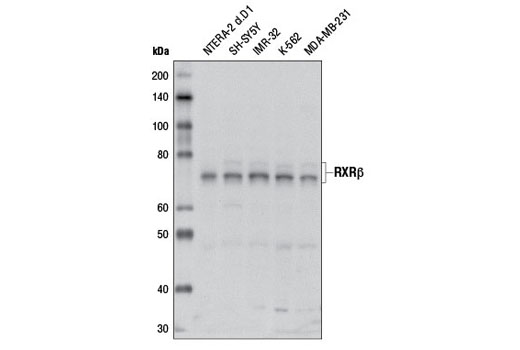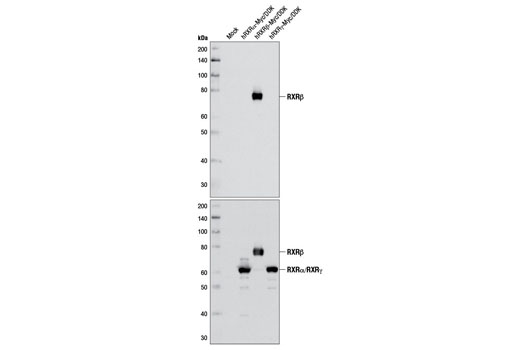WB, IP
H M
Endogenous
70-72
Rabbit
#P28702
6257
Product Information
Product Usage Information
| Application | Dilution |
|---|---|
| Western Blotting | 1:1000 |
| Immunoprecipitation | 1:50 |
Storage
Specificity / Sensitivity
Species Reactivity:
Human, Mouse
Species predicted to react based on 100% sequence homology
The antigen sequence used to produce this antibody shares
100% sequence homology with the species listed here, but
reactivity has not been tested or confirmed to work by CST.
Use of this product with these species is not covered under
our
Product Performance Guarantee.
Rat, Monkey, Bovine, Dog, Pig
Source / Purification
Polyclonal antibodies are produced by immunizing animals with a synthetic peptide corresponding to residues near the amino terminus of human RXRβ protein. Antibodies are purified by protein A and peptide affinity chromatography.
Background
The human retinoid X receptors (RXRs) are encoded by three distinct genes (RXRα, RXRβ, and RXRγ) and bind selectively and with high affinity to the vitamin A derivative, 9-cis-retinoic acid. RXRs are type-II nuclear hormone receptors that are largely localized to the nuclear compartment independent of ligand binding. Nuclear RXRs form heterodimers with nuclear hormone receptor subfamily 1 proteins, including thyroid hormone receptor, retinoic acid receptors, vitamin D receptor, peroxisome proliferator-activated receptors, liver X receptors, and farnesoid X receptor (1). Since RXRs heterodimerize with multiple nuclear hormone receptors, they play a central role in transcriptional control of numerous hormonal signaling pathways by binding to cis-acting response elements in the promoter/enhancer region of target genes (2).
RXRβ, like other members of the RXR subfamily, possesses a characteristic tripartite modular structure consisting of (a) a highly conserved central region containing the C4/C5 zinc-finger domain, which is responsible for DNA binding; (b) a relatively well-conserved C-terminal region, which contains the hormone binding and dimerization domains; and (c) a variable N-terminal domain, which has been implicated in either transactivation or repression of target genes (2). Variability within the N-terminal domain is thought to be the result of alternative splicing and/or differential promoter usage (3-5). The murine RXRβ was initially identified because of its ability to bind to the regulatory region II in the murine major histocompatability complex (MHC) class I promoter and is therefore also referred to as H-2RIIBP (6). Genetic ablation of murine Rxrb produced approximately 50% lethality in utero and males that survived had defects of spermatazoa, which resulted in sterility (7). Further studies revealed that expression of a Rxrb mutant with an impaired AF-2 core led to abnormal lipid metabolism in Sertoli cells, suggesting functional interactions between Rxrb and other nuclear receptors that control lipid metabolism (8).
- Gronemeyer, H. et al. (2004) Nat Rev Drug Discov 3, 950-64.
- Mangelsdorf, D.J. et al. (1992) Genes Dev 6, 329-44.
- Nagata, T. et al. (1994) Gene 142, 183-9.
- Fleischhauer, K. et al. (1993) Hum Genet 90, 505-10.
- Fleischhauer, K. et al. (1992) Nucleic Acids Res 20, 1801.
- Hamada, K. et al. (1989) Proc Natl Acad Sci USA 86, 8289-93.
- Kastner, P. et al. (1996) Genes Dev 10, 80-92.
- Mascrez, B. et al. (2004) EMBO Rep 5, 285-90.
Species Reactivity
Species reactivity is determined by testing in at least one approved application (e.g., western blot).
Western Blot Buffer
IMPORTANT: For western blots, incubate membrane with diluted primary antibody in 5% w/v BSA, 1X TBS, 0.1% Tween® 20 at 4°C with gentle shaking, overnight.
Applications Key
WB: Western Blotting IP: Immunoprecipitation
Cross-Reactivity Key
H: human M: mouse R: rat Hm: hamster Mk: monkey Vir: virus Mi: mink C: chicken Dm: D. melanogaster X: Xenopus Z: zebrafish B: bovine Dg: dog Pg: pig Sc: S. cerevisiae Ce: C. elegans Hr: horse GP: Guinea Pig Rab: rabbit All: all species expected
Trademarks and Patents
Limited Uses
Except as otherwise expressly agreed in a writing signed by a legally authorized representative of CST, the following terms apply to Products provided by CST, its affiliates or its distributors. Any Customer's terms and conditions that are in addition to, or different from, those contained herein, unless separately accepted in writing by a legally authorized representative of CST, are rejected and are of no force or effect.
Products are labeled with For Research Use Only or a similar labeling statement and have not been approved, cleared, or licensed by the FDA or other regulatory foreign or domestic entity, for any purpose. Customer shall not use any Product for any diagnostic or therapeutic purpose, or otherwise in any manner that conflicts with its labeling statement. Products sold or licensed by CST are provided for Customer as the end-user and solely for research and development uses. Any use of Product for diagnostic, prophylactic or therapeutic purposes, or any purchase of Product for resale (alone or as a component) or other commercial purpose, requires a separate license from CST. Customer shall (a) not sell, license, loan, donate or otherwise transfer or make available any Product to any third party, whether alone or in combination with other materials, or use the Products to manufacture any commercial products, (b) not copy, modify, reverse engineer, decompile, disassemble or otherwise attempt to discover the underlying structure or technology of the Products, or use the Products for the purpose of developing any products or services that would compete with CST products or services, (c) not alter or remove from the Products any trademarks, trade names, logos, patent or copyright notices or markings, (d) use the Products solely in accordance with CST Product Terms of Sale and any applicable documentation, and (e) comply with any license, terms of service or similar agreement with respect to any third party products or services used by Customer in connection with the Products.


